Table of Contents
Key Takeaways
- Mushrooms have been used for food and medicine for centuries, with some species showing potential therapeutic benefits for human health.
- There are six nootropic mushrooms: Chaga, Cordyceps, Lion’s Mane, Maitake, Oyster, and Reishi, each with distinct therapeutic properties.
- Genuine mushroom nootropic supplements should be correctly identified to avoid inferior products, and the presence of beta-D-glucans indicates quality.
- Choose high-quality, certified organic, hot-water extracted mushroom supplements and check product labels for “fruiting body,” “beta-glucans,” and no “mycelium.”
- Products from companies like Real Mushrooms and Mind Lab Pro® meet the criteria for the best nootropic mushroom supplements.
Mushrooms have been used by humans for thousands of years as food and medicine.
More than 14,000 species of mushrooms have been identified and about 2,000 of them are edible.
Of 2,000 edible mushrooms, 270 species have potential therapeutic or preventative agents that ensure human health.
But of 270 medicinal mushrooms, only 6 are considered nootropics. And provide some type of benefit for your brain and nervous tissue.
In this post you’ll discover the nootropic value of those 6 mushrooms. Including how they benefit learning and memory, anxiety, fatigue, and the potential for Alzheimer’s Disease.
Then you’ll learn how to identify a genuine mushroom nootropics supplement. We’ll also cover how to avoid misleading marketing tactics that could trick you into buying bogus mushroom supplements.
And the last section of this article provides suggestions on where to buy the highest quality nootropic mushrooms.
Top 6 Nootropic Mushrooms for Supporting Brain Health
270 species of edible mushrooms have been researched and tested as providing therapeutic or preventive benefits.
But so far, only 6 mushroom species have been identified with plenty of evidence to work as a nootropic and benefit your brain.
Chaga (Inonotus obliquus)
Chaga mushrooms are technically NOT a mushroom but a canker that grow naturally on birch trees in northern Canada, Alaska, Siberia, Northern Europe, and Korea.
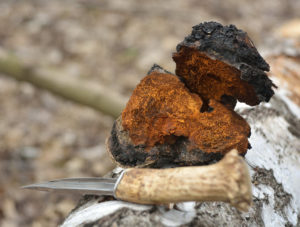
Traditional medicine in the Northern Hemisphere used Chaga Mushrooms to inhibit cancer progression, stimulate immunity, reduce inflammation, and liver protection.[i]
In the lab, Chaga has been shown to be antitumor, anti-mutagenic, antiviral, antidiabetic, antioxidant, and analgesic (pain relief).
Animal studies demonstrated Chaga as an acetylcholinesterase inhibitor which boosts acetylcholine for better learning and memory.[ii]
Another study showed Chaga is a potent antioxidant and scavenges free radicals.[iii]
Do not use Chaga if you’re on blood thinning medication, diabetes medication or if you have kidney disease.
Chaga is high in oxalates, which may prevent the absorption of some nutrients and can be toxic in high doses.
Chaga is available in capsules, bottled tinctures, as an extract, in tea bags, and fresh raw mushroom. Dosages vary between brands.
Other than as an extract, Chaga is best absorbed in hot water, alcohol, or fermented. If you’re using Chaga powder or tea bag, let it steep in hot water for 5 minutes before using it.
You can buy the highest quality, certified organic, hot-water extracted Siberian Chaga extract from Real Mushrooms located in Roberts Creek, British Columbia. First time buyers get a 25% discount and return customers can use my special discount code on checkout: Nootropics10
Cordyceps (Cordyceps militaris)
In the wild, Cordyceps (sinensis) grows as a parasitic fungus on caterpillars. Cultivated Cordyceps (militaris) which is mass produced for the supplement industry has been found to have similar components as sinensis. And may yield higher quantities of active compounds.[iv]
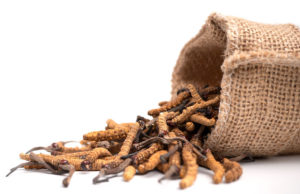
Cordyceps mushrooms have been used in traditional Chinese medicine to treat fatigue, respiratory and kidney disease.
Over 200 clinical studies show Cordyceps mushrooms improves performance by increasing blood flow, boosts ATP synthesis for more natural energy, acts as an antioxidant, enhances lactate clearance, increases the release of catecholamines, and reduces oxidative stress, and fatigue.[v]
Cordyceps first gained attention in 1993, when world record-breaking performances of Chinese female athletes were attributed to a vigorous training and nutrition regimen that involved Cordyceps supplementation.[vi]
A study conducted in Japan showed significant increases in the concentrations of creatine, and all the catecholamines in men over of the course of 2 weeks who were supplementing with Cordyceps sinensis.
The researchers concluded that “during this prolonged exercise, ingesting with Cordyceps mushrooms might elicit the superior efficiency and the economical function on the energy metabolism”.[vii]
You will get the most benefit of supplementing with Cordyceps by using 4 grams per day for at least 3 weeks.
I recommend Real Mushrooms 100% Certified Organic Cordyceps extract. First time customers get a 25% discount and return buyers can use my discount code: Nootropics10.
Lion’s Mane Mushroom (Hericium erinaceu)
Lion’s Mane Mushroom is an ancient Chinese remedy for improving cognitive function, and for overall health.
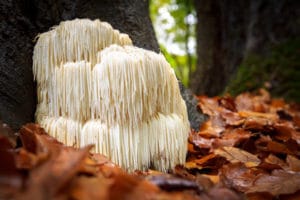
You’ll find my full review for Lion’s Mane Mushroom here.
Known for its powerful effects as a “brain tonic”, Lion’s Mane is said to have been used as a tea for thousands of years by Buddhist monks. To enhance brain power and heighten their ability to focus during meditation.
Lion’s Mane stimulates enzyme production that releases Nerve Growth Factor (NGF). In a study done in Kuala Lumpur in 2013, scientists showed that Lion’s Mane extract induced NGF synthesis and promoted neurite outgrowth.[viii]
Nerve Growth Factor helps repair neurons in your brain and boosts the regrowth of lost nerve cells and the growth of new neurons (neurogenesis). For better learning and memory.
Dosage of Lion’s Mane depends on the strength of the extract. Ranging from 300 mg to 3000 mg dosed 1 – 3 times per day.
My favorite pre-made nootropic stack Mind Lab Pro® contains the genuine fruiting body of Lion’s Mane Mushroom as well. I have been using Mind Lab Pro every day for the last 5 years and it is by far the best pre-made stack on the market today.
If you’re looking for a standalone Lion’s Mane supplement I also use and recommend Real Mushrooms Lion’s Mane extract. It is certified 100% organic with >25% Beta-D-Glucans hot-water extract. First time buyers get a 25% discount and return customers can use my discount code: Nootropics10
Maitake (Grifola frondosa)
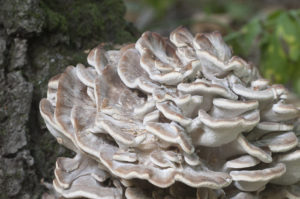
The Maitake mushroom is native to northeastern Japan. Its rippling appearance with no caps is a bit like that of dancing butterflies. Hence its name is derived from the Japanese words Mai (dance) and take (mushroom).
Maitake mushrooms are used to support some cancer therapies, chronic fatigue, hepatitis, allergies, high blood pressure and cholesterol.
Its nootropic value comes from its ability to relieve depression.
Studies show that the expression of AMPA receptors are reduced in patients with depression.[ix] And antagonists that sensitize AMPA receptors help prevent depression.
Animal models show that supplementing with Maitake provides an antidepressant effect by sensitizing AMPA receptors. And the researchers concluded that “patients may just eat Maitake as a supplement for the treatment of depression.[x]
Recommended dosage of Maitake Mushroom extract is 250 – 500 mg per day.
Oyster (Pleurotus ostreatus)
Oyster mushrooms are of Asian origin, but first cultivated in Germany during the first World War as an alternative food source. It’s
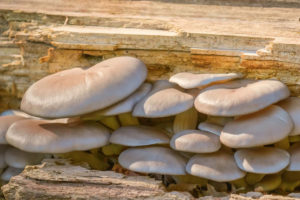
now the 3rd highest in quantity of the commercially produced mushrooms worldwide.
Oyster mushrooms are high in protein and a good alternative to animal meat because they contain some of the same amino acids as found in animal protein. Making Oyster mushrooms a good protein source for vegetarians.
Oyster mushrooms are also a good source of the B-Vitamins, Vitamin C, Vitamin D, and several minerals.[xi]
The nootropic benefits of Oyster mushroom extract are attributed to and include anti-bacterial, antiviral, antitumor, anti-inflammatory, and works as an antioxidant by suppressing oxidative stress and as a free radical scavenger.
Trials are undergoing and testing Oyster Mushrooms ability to degrade plastic waste, crude oil, and even radioactive waste.[xii]
Reishi (Ganoderma lucidum)
Reishi mushroom has been used for over 2000 years in traditional Chinese Medicine.
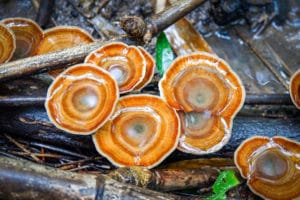
In China, G. lucidum is called lingzhi. In Japan, the name for the Ganodermataceae family is reishi or mannentake.[xiii]
Reishi mushroom benefits include blood sugar regulation, antioxidant, antibacterial, antiviral, and anti-tumor.[xiv]
As a nootropic, Reishi is used for its anti-anxiety benefits[xv] and for chronic fatigue syndrome.
A study at Mae Fah Luang University in Thailand recruited 50 volunteers suffering Chronic Fatigue Syndrome. Each were given Reishi mushroom extract or placebo.
Each person was asked to respond to a questionnaire for quality of life score and level of fatigue before and 4, 8, and 12 weeks after the first dose.
At the end of the study, those who used Reishi mushroom extract reported a significant increase in quality of life compared to placebo with a decrease in fatigue.
The researchers concluded that “G. lucidum extract could be potentially effective in the treatment of fatigue and improve quality of life in Chronic Fatigue Syndrome patients.”[xvi]
Many ‘in-vivo’ studies demonstrate the benefits of Reishi mushroom to include boosting your immune system[xvii], preventing abnormal blood vessel formations, it’s anti-tumor, and helps reverse liver damage.
Another animal study showed that Reishi mushroom could play an important role in Alzheimer’s Disease treatment. And as a nootropic, it supports the growth of Nerve Growth Factor (NGF).[xviii] NGF boosts learning, memory, and longevity.
Reishi mushroom is available in capsules, as a powder, and as an extract. Dosages vary depending on the strength or how concentrated the extract.
The Pharmacopoeia of the People’s Republic of China recommends 6 to 12 g Reishi extract daily.
I recommend Real Mushrooms 100% Organic Reishi Mushroom extract. First time buyers get a 25% discount and return buyers can use my discount code: Nootropics10
How to Buy Genuine Nootropic Mushrooms
The beauty of mushrooms as a food and the few that are considered for their nootropic cognitive benefit is that they’re natural, and free of pesticides.
And as nootropics and a functional food, are high in vitamin, mineral and protein content. As well as being neuro-active and as antioxidants.
But a word of caution here.
You can usually find any of the 6 mushrooms I detailed above in a vitamin shop or online for use as a nootropic supplement. But the challenge is choosing nootropic mushroom supplements that work as claimed.
How the mushroom is grown and processed as well as the part of the mushroom used will affect its value as a nootropic.
Just one of many examples, the processing method (oven-dried vs freeze-dried) for Lion’s Mane Mushroom has been shown to affect its neurite stimulation activity.[xix]
Here you’ll learn about the different parts of a mushroom. And depending on how its grown and the part used, which supplements will offer the most nootropic value.
Choose the wrong supplement and you won’t get its benefit.
Unfortunately, manufacturers often make it difficult to discern what method was used to make their mushroom supplement.
Once you learn how to read the label, you’ll have more confidence knowing you’re buying the best nootropic mushrooms.
Understanding the Market of Nootropic Mushrooms
What we call a “mushroom” is made up of two parts – the mycelium and the fruiting body. The top of the mushroom is the fruiting body. And its stem is the mycelium.
NOTE: mycelium and mushroom is not synonymous.
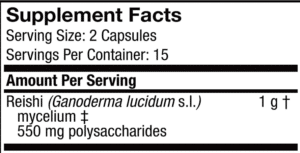
If the supplement label states that the contents are ‘mycelium’, you’ll know you’re NOT getting a mushroom supplement. More on that in the next section.
The active components in a mushroom are what dictate their benefit to your cognition and overall health.
Those active components are beta-D-glucans, triterpenoids and ergosterol.[xx]
Beta-D-glucans are the primary source of nootropic activity. They make up the natural structural component of the cell walls of the fruiting body of the mushroom.
Triterpenoids compliment beta-D-glucans in immune system activity. And along with Ergosterol offer antioxidant activity, reduced inflammation, liver protection and reduced histamine response.
Genuine Mushrooms vs Mycelium
What you refer to as a ‘mushroom’ is actually the ‘fruiting body’ of the mushroom. Which develops from a spore, grows into the mycelium, and then tops it off with a mushroom (fruiting body).
Mycelium is the underground network that acts like a root which feeds off of organic plant matter.
This plant matter is usually referred to as substrate. The mycelium becomes woven into whatever that substrate is and is inseparable from the substrate material.
If all goes well, the mycelium produces a mushroom (fruiting body). The fruiting body is the reproductive mechanism of this organism.
When fully mature, the fruiting body produces spores that enter the substrate matter. To go on to produce more mycelium.
The bottom-line is a mushroom is not mycelium, and mycelium is not a mushroom.
The only exception to this ‘rule’ is Lion’s Mane Mushroom. Because the fruiting body does not contain erinacines which is the compound known to stimulate Nerve Growth Factor (NGF).
The nootropic benefits of hericenones are only found in the fruiting body or top of the mushroom and help support your immune cells and get rid of Amyloid β(25-35) peptide implicated in diseases like Alzheimer’s.
The challenge is getting a Lion’s Mane Mushroom extract that contains the full spectrum found in both the mycelium and fruiting body.
But the mushroom must be grown in liquid and not a solid substrate like grain. Otherwise you’ll get ground up grain without the important erinacines needed for increased NGF.
The nootropic value of mushrooms: beta-D-glucans
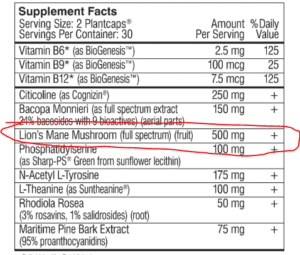
Functional nootropic mushroom benefits come from their active compounds which are found primarily in the mushroom (fruiting body). And much less so in the mycelium.
The fruiting body contains Beta-D-glucans which modulate your body’s immune function, reduce inflammation, control blood sugar, help reverse fatigue symptoms, and increase overall performance endurance.[xxi]
As the mycelium grows down into the substrate matter the two become interwoven. And cannot be separated during processing when manufacturing supplements.
Mushroom supplement manufacturers often claim their product is pure “mushroom” extract. But what you may be getting instead is a mycelium supplement combined with substrate matter.
Check the ‘Supplement Facts’ label on the back of a “mushroom” supplement to ensure you’re getting the “fruiting body” and not “mycelium” instead.
Polysaccharides does NOT Equal Mushroom Quality
Polysaccharides is another term you’ll come across on mushroom supplement labels.

Truth is they are a key component in nootropic mushrooms. And companies boast about their high polysaccharide numbers.
But here’s the problem with evaluating a mushroom supplement simply by measuring polysaccharides.
Polysaccharides are long chain carbohydrates made up of components like beta-glucans, chitin, cellulose, glucose, and fructose.
But polysaccharides also include alpha-glucans such as glycogen, dextran, pullulan, and starch.
Many so-called “mushroom” products are made up of alpha-glucans and not beta-glucans.
The thing is a lot of medicinal mushroom supplements on the market are just mycelium which is grown on grain. And the grain cannot be separated from the mycelium that it’s entangled with.
These grains are alpha-glucans, starches, and other fillers which are part of the grain substrate the mushroom is grown on. And are passed off as “mushroom” supplements to those who haven’t done their homework.
Alpha-glucans provide no nootropic benefit.
Unless you inspect the nootropic mushroom label carefully, you may be misled into believing that you are buying a genuine mushroom supplement.
When in fact, you could be buying a bottle filled with mycelium/grain powder.
Six researchers conducted and published a study in partnership with the US Pharmacopoeia to evaluate 19 Reishi mushrooms. The supplements were purchased online from Amazon and eBay.
Only 5 of the 19 supplements tested contained genuine Reishi mushroom. The supplements evaluated in this study included 6 fruiting body powders, 1 fruiting body powder with added polysaccharides, 1 reishi mycelium product and 11 extracts.
The researchers concluded that several so-called ‘Reishi’ mushroom supplements did NOT contain what consumers expected based on product information and labels.[xxii]
The big take-away here is just because you see a picture of a mushroom on the front of a supplement bottle does NOT guarantee any genuine mushroom fruiting body in the supplement.
To get the most potent nootropic mushroom supplement, look for extracts made from the mushroom (fruiting body) and which also specifies beta-glucan content.
Do NOT buy a mushroom supplement if the manufacturer neglects to state the part of the mushroom they use.
The bottle or package should say whether you’re getting the mushroom (fruiting body), the mycelium, or a blend of both. How much of each including the percentage (%) of beta-glucan content. If not, put it back on the shelf.
Nootropics Mushrooms and Brain Health Summary
China is the leading grower worldwide of medicinal mushrooms accounting for 90 – 95% of world production.
China first began growing mushrooms for food and medicine in the 13th century. Many of the research centers dedicated to the study and development of mushrooms are in China.
Mushrooms grown in the United States or Canada are too expensive for nootropic supplement use.
If your supplement label states “Made in the USA” double-check and make sure that you are buying genuine mushroom. Because if it’s an extract and whole “fruiting body”, the mushrooms are grown China. Even if the extract was manufactured in the USA.
If the company insists their product was grown in the USA or Canada, you can be sure that the contents of that supplement are mycelium/grain powder and not genuine mushroom (fruiting body).
When choosing a nootropic mushroom it’s important to keep in mind that for you to get it’s nootropic benefit it needs to be 100% mushroom (fruiting body), with verified levels of beta-glucans, zero fillers, and preferably certified organic.
Lion’s Mane Mushroom is one of the best nootropic mushrooms. Get it as a standalone supplement, or part of a pre-made stack like my favorite, Mind Lab Pro®.
Mind Lab Pro® contains 500 mg of Organic Lion’s Mane Mushroom (full spectrum & fruiting body) per dose.
If you’d like to try a pre-made stack containing most of the nootropic mushrooms detailed in this review, I suggest trying the Onnit Shroom Tech.
Their Onnit Shroom Tech includes 8 different medicinal mushrooms species including our 5 nootropic mushrooms.
And most of the nootropic mushrooms I’ve detailed above can be purchased as standalone supplements. I recommend Real Mushrooms who are the pioneers in this industry and have set the bar for the highest quality nootropic mushrooms. They are located in Roberts Creek, British Columbia. And their mushroom products are Certified 100% Organic, using the fruiting body only with the highest Beta-D-Glucan content.
First time buyers at Real Mushrooms get a 25% discount. And return buyers can use my discount code: Nootropics10

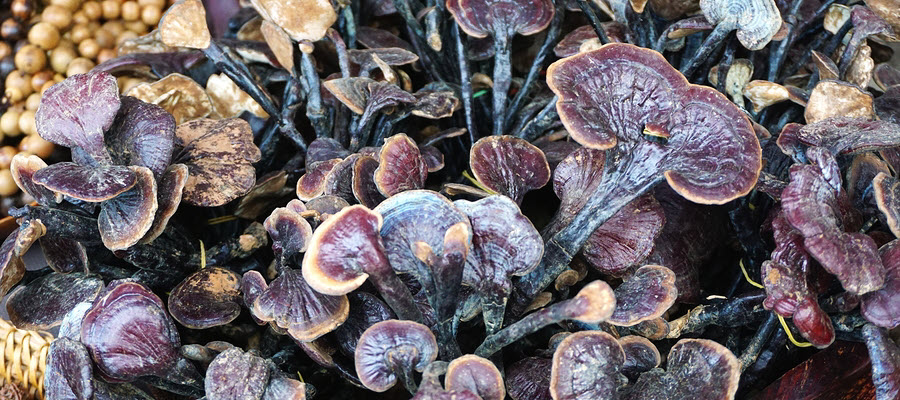





Join The Discussion - 45 comments
Jack Murray
December 22, 2022
Have been looking for months now of Nootropic Mushrooms. This was recommended to me by my close friend. he said that mushrooms can help have a good sleep which I find it hard for months now.
David Tomen
December 26, 2022
Jack, I am not aware of any nootropic mushroom providing direct help with sleep. But in general as healthy brain (i.e. supported by using nootropic mushrooms) should help with sleep.
steve
August 14, 2022
I recently made my own double extraction tincture of lion’s mane, chaga, cordyceps and reishi. my mushrooms were from foragers and small batch concious cultivaters. Im over sixty and my father is in his mid nineties and we were looking to keep our optomize our brain functions.the tincture has really helped us both. what ingredients do you suggest I add to my my current recipe to improve it?
David Tomen
August 16, 2022
Steve, if you can find a grower of Oyster (Pleurotus ostreatus) it would be helpful.
Brian
July 11, 2022
Hi David,
Any thoughts on taking cordyceps and nac, any issue that you have seen? I currently take cordyceps (500mg) and love it. take for copd. I also take reishi which I love. I have added nac (600mg might to to 1200mg) for Brain Health and I have read that also helps with copd. I was unsure if taking both would be an issue. thanks,
David Tomen
July 12, 2022
Brian, I cannot think of anything that is contraindicated with NAC. It’s a natural amino acid and precursor to the synthesis of glutathione. And it helps repair dopamine receptors. Nothing in there is going to cause problems by using it with Cordyceps.
Michael
May 19, 2022
Hi David! I found 30:1 cordyceps extract with 40% polysacharides. What dosage should I use?
David Tomen
May 20, 2022
Michael, it’s not the polysaccharide but beta-glucans that provide nootropic benefit. So I cannot suggest a dosage unless I know the beta-glucan content.
Henry
March 3, 2022
Hi David,
Are you considering reviewing cistanche?
Many thanks
David Tomen
March 4, 2022
Henry, it’s not on my list. But if I can find enough evidence that it benefits the human brain I will review it. Thanks for the tip.
Sandra
February 2, 2022
Hi David!
I’ve read that Maitake sensitizes AMPA receptors, is it the same as activating? Will this do the same as resveratrol or rhodiola if I want to have more motivation?
Or only rhodiola and resveratrol are the ONLY “natural” suplements that activate AMPA?
Please forgive me David for so many question, I am just so curious about all of this stuff!
Thanks!
David Tomen
February 2, 2022
Sandra you are correct that Maitake activates AMPA receptors. So should help with motivation as well.
Sandra
February 3, 2022
Thank you David! May I ask you one more question please?
Can I activate AMPA too much? There are much more suplements (even those which aren’t reviewed by you yet which activate AMPA) I think that maybe If I add more AMPA stimulators I should get more motivation?
I already try to suplement with Maitake, noopept, rhodiola and resveratrol for AMPA
David Tomen
February 3, 2022
Sandra, be careful because I have learned the hard way that more is not better. You can only do so much and at that point go with what works. Please trust me on this.
The only supplements I think you should add to this stack are L-Tyrosine 500 mg twice per day, CDP-Choline 300 mg twice per day (because Noopept needs it), and a high quality multi like this one: https://bit.ly/2EIyhCA
B L
December 29, 2021
Hi David,
I have a little experience with nootropics, but have not really found what I am looking for. I really struggle to get out of bed every day and the mornings are very slow for me. It’s a lot like wading through sludge. I’m a very happy person so depression is not an issue. Do you know if there’s a mushroom or nootropic that might help with this? Thanks for any suggestions.
David Tomen
December 29, 2021
Belinda, it depends on the cause of your fatigue. But when it comes to mushrooms your best option to try are Cordyceps and Reishi.
Ann W.
August 24, 2021
David,
I just ordered Reishi 415 from Real Mushrooms. I’m excited to try this supplement and will likely take it in the evening, in case it makes me sleepy. I’m already taking 500mg L-tryptophan with magnesium at night. It is ok to take Reishi and L-tryptophan at the same time?
Thanks
Ann
David Tomen
August 27, 2021
Yes